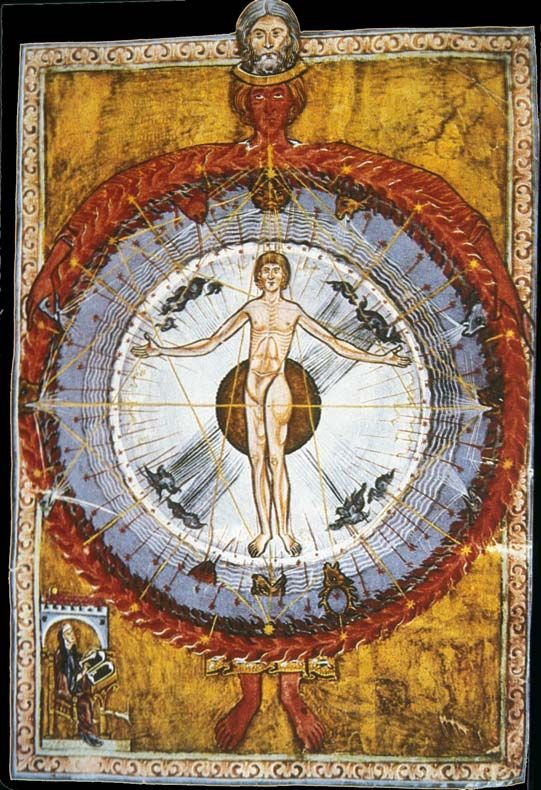Hildegard de Bingen (1098-1179) was born into a wealthy family in Germany, birth date not quite certain. She was her parents tenth child, and had 'visions' , the earliest when she was about three years old. Her parents didn't know what to do with her, so they shipped her off to a convent when she was eight. This was the best thing that could have happened to her. Convents were the only places females had access to education. She was taken under the wing of a nun named Jutta, who became her teacher and mentor. She was very intelligent, learned to read, write, create illuminated manuscripts, play and compose music, etc... This painting above is her receiving one of her visions from God. Her friend, a monk named Volmar, who became her secretary, watches. (Yes, she was a female with a male assistant!)
All of Hildegarde's paintings are from
her visions. They all rethink the doctrines of the Catholic church from a
female, matriarchal perspective. This one is called Forms of the
Church, it's a giant Eve there, holding her Sisters of Wisdom in her
arms. Girl power all the way!!
Some of her paintings remind me of
mandalas. This one is called The Cosmic Egg, like a woman's womb, it
shows the universe surrounded by fire, the blue is the sky, in the
center are the four elements, bringing nutrients to the entire 'egg'.
She said,'woman may be made from man, but no man can be made without a
woman'.
Hildegard went on to become the head of her convent, the Abbey of Rupertsberg. Women flocked to join her in droves. Her visions were 'approved' by the pope, and she was given considerable power. When she wanted more independence, she moved her whole convent away from a nearby monastery. Her community flourished. She wrote nine books, plays, composed music. She lived into her 80s.
Hildegard went on to become the head of her convent, the Abbey of Rupertsberg. Women flocked to join her in droves. Her visions were 'approved' by the pope, and she was given considerable power. When she wanted more independence, she moved her whole convent away from a nearby monastery. Her community flourished. She wrote nine books, plays, composed music. She lived into her 80s.
Jonah Winter wrote a children's book about her, The Secret World of Hildegard, illustrated by his mom, Jeanette Winter.










Geen opmerkingen:
Een reactie posten